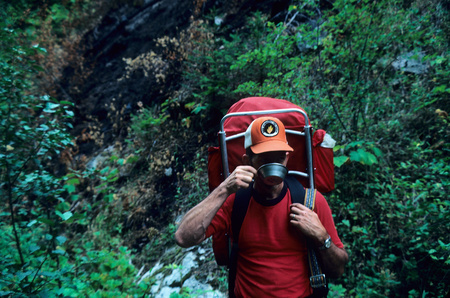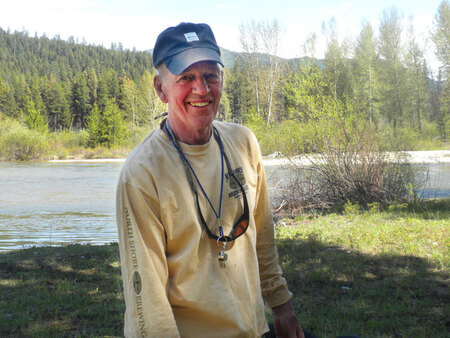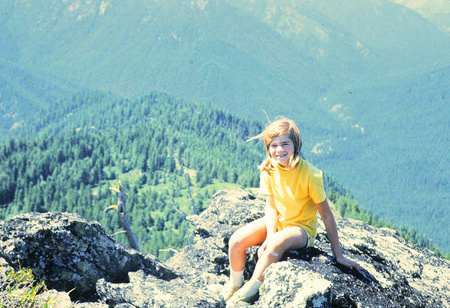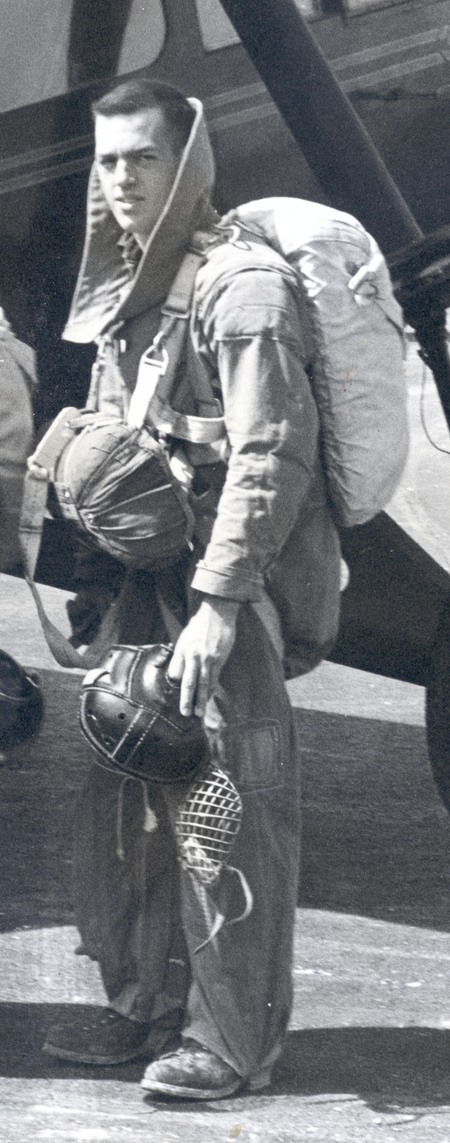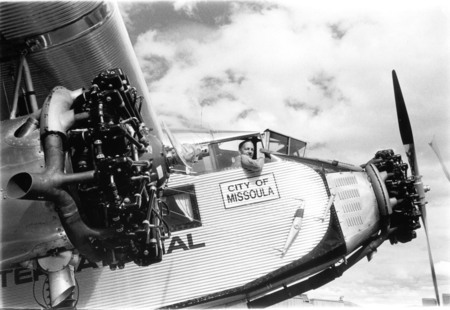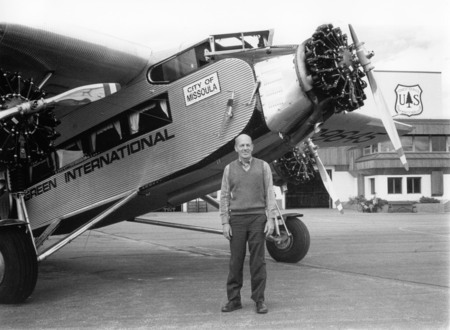Episode 15 : To The Next Generation : an interview with Bob Mutch Item Info
In this episode, titled “To The Next Generation,” we hear from Bob Mutch, who passed on his love for the Selway-Bitterroot Wilderness to his daughter, Linda, and reminisces about the time they spent together in the backcountry.
Bob’s areas of special interest include forest fuel management, fire ecology, fire behavior prediction, wildland fire training, public and firefighter safety, wildland fire suppression, prescribed fire in wilderness management, fire safe strategies for the interface, and international assistance. Since 1994, he has served as a fire management consultant in Brazil, Bulgaria, Ethiopia, India, Italy, and Mongolia for the United Nations and the World Bank, as well as domestic projects in the United States.
After her years of accompanying her father into the Selway-Bitterroot Wilderness, Linda went on to do her Master’s degree at the University of Arizona Tree-Ring Lab in a fire-related tree ring study on giant Sequoia trees, and has continued the work her father began studying wilderness fire behavior and management.
Episode 15 : To The Next Generation : an interview with Bob Mutch [transcript]
00:00:00:00 - 00:00:29:01 Debbie Lee: Welcome to the Subway Bitterroot Wilderness History Project, which is made possible by a grant from the National Endowment for the Humanities. The University of Idaho, and Washington State University. Part of the project’s mission is to collect, preserve, and make public oral histories documenting the history and people of the subway. Bitterroot wilderness. For more information, please visit our website at SPW lib argue Idaho redo.
00:00:29:03 - 00:00:54:01 Debbie Lee: And then I think people, I think people get so much out of being in a wilderness setting. Once you take away cars and money and telephone and people are different and they are different to each other, I think. And, and, and then they draw on things in themselves that maybe are a little rusty from our crazy life out here.
00:00:54:01 - 00:01:25:06 Debbie Lee: Now, I think the ways that people get along when they’re isolated in a place like that, that they place that they want to be familiar, is a wonderful thing.
00:01:25:09 - 00:02:04:04 Debbie Lee: Thank you for joining us for the 15th episode of the Selway Bitterroot Wilderness History Project. In this episode titled To the Next Generation, we hear from Bob Munch, who passed on his love for the subway Bitterroot Wilderness to his daughter Linda, and reminisces about the time they spent together in the backcountry. Bob’s areas of special interest include forest fuel management, fire ecology, fire behavior prediction, wildland fire training, public and firefighter safety, wildland fire suppression, prescribed fire in wilderness management, fire safe strategies for the interface, and international assistance.
00:02:04:07 - 00:02:32:26 Debbie Lee: Since 1994, he has served as a fire management consultant in Brazil, Bulgaria, Ethiopia, India, Italy and Mongolia for the United Nations and the world Bank, as well as domestic projects in the United States. After her years of accompanying her father into the South Bitterroot Wilderness, Linda went on to do her master’s degree at the University of Arizona Tree Ring Lab and a fire related tree ring study on giant sequoia trees, and she has continued the work.
00:02:32:26 - 00:02:37:25 Debbie Lee: Her father began studying wilderness fire behavior and management.
00:02:37:27 - 00:02:49:00 Debbie Lee: So, Bob, can you tell me when you first like, what was your very first experience on the land? That’s the survey. Bitterroot and whether you can remember.
00:02:49:03 - 00:03:10:00 Bob Mutch: That’s pretty easy because it was such a memorable moment for me, I guess. So it goes all the way back to 1970. And although I knew there was a Snow White bitterroot over the mountains from Missoula and I smoked Jim in Missoula in 54 and five, I guess I’m going to have to take that back, because on, my very first fire.
00:03:10:00 - 00:03:38:27 Bob Mutch: Jo, come to think of it right now, sitting with you, it was a fire in the snowy wilderness. It was a little two person fire in 1954 as my first fire job. So I’m mistaken in thinking that 70 was my first experience in the seminary, I guess. I guess I came back to come by it very honestly. The fire in the Selway and Bob, my school all the way back to when I was in college in Michigan and smoke coming out of out of Missoula.
00:03:39:00 - 00:04:10:18 Bob Mutch: And I think it was a little place called Hamby Point H, Amber’s. You might check that on a map, but it was a little two person fire, and I jumped with a, veteran smokejumper, Ed Wayne, on this fire. That was just a single snag that was struck by lightning. Like so many fires are, and it was easy to put a line around and felled a snag and put it out, and we wiped out, a couple days later.
00:04:10:18 - 00:04:22:10 Bob Mutch: But yeah, that was very interesting to discover for myself that my roots go back in the cell way further than I had remembered. That’s the beauty of an oral history, I guess.
00:04:22:13 - 00:04:28:18 Debbie Lee: So. And then in the 7 in 1970, you returned. And back then.
00:04:28:22 - 00:04:59:12 Bob Mutch: Yeah, 1970, it was my more official and more long lasting, tired of the Snow White bitterroot. So my daughter at that time. Yeah, 1917, born in 1906 and she was ten years old and she loved the outdoors. And I said, Linda, how would you like to go on a backpack trip this weekend into the Selway? So we drive for Missoula, 135 miles to Paradise Park at the guard station, hike up to Cooper’s Flat cabin and eight and a half miles with our backpack.
00:04:59:20 - 00:05:26:18 Bob Mutch: Linda had a little Trapper Nelson pack, and she still rues the day that she had this uncomfortable, terrible torture rack pack. As a little kid growing up. Whitecap, correct for eight and a half miles and. But we got to Cooper’s flat out and had a nice supper there. Had use of the cabin. Next day we made a day trip up high on a trail behind Cooper’s Flat to a place called Vantage Point.
00:05:26:18 - 00:05:55:11 Bob Mutch: I took several pictures. The Landon pictures will end up pointing to big fire scars on on Ponderosa pine. And I and I used to go over there, you know, nights and weekends in the summers. It was just Bob much and his forest and, and then this something, I mean, you know, I miss value programing, I’m sure big time and and it and it stuck and it really meant something to me.
00:05:55:13 - 00:06:21:29 Bob Mutch: And, talking about value programing, I just have to mention Linda because I started out talking about Linda when she was ten. For those three years, we were doing the white calf study. She liked that first backpack, even though she didn’t like the trapper. Nelson. I had to get her a better pack for many, many of my ten day on for day off hitches that I did for the next 2 or 3 years.
00:06:22:02 - 00:06:41:01 Bob Mutch: I would the next summer would ask Linda, would you like to go in with me? I’m going in for ten days and I’d love to have your company. So she went in with me. Ten, 11, 12 years old. I didn’t know this at the time. You know, you talk about wilderness.
00:06:41:03 - 00:06:42:11 Debbie Lee: Do you want me to stop it?
00:06:42:18 - 00:07:14:06 Bob Mutch: No. I’m okay. You talk about wilderness of people and its effect on people. But this story always gets me. Because, you know, wilderness is about nature. But just as importantly, it’s about people in nature and the effect of nature on people and the fact of people on nature. And I didn’t know it at the time when Linda accompanied me on trip after trip in the cell, was actually helping me with my vegetation plot work.
00:07:14:06 - 00:07:42:29 Bob Mutch: And we’re in there ten days and camped out and campfires at night and backpacks and freeze dried meals to the point where I think both of us were glad to get back to town for a milkshake after ten days in the woods. But, sometime in that period or shortly after it, I went to hear a psychologist from the, University of Colorado Boulder speak, and he was very well known, psychologist.
00:07:42:29 - 00:08:12:00 Bob Mutch: And he was very, very theatrical in his presentations. And he was so good that the Forest Service hired him to do workshops for Forest Service employees, because the title of at least one of his presentations had made such a huge, huge impression on me was simply this you are what you were. When, in other words, when we were nine, ten, 11, 12, we had little control over.
00:08:12:00 - 00:08:45:26 Bob Mutch: We were value programing for the rest of our lives and what we were exposed to at those young years were going to live with us for the rest of our lives, he said. Unless someone gave you a significant emotional experience that somehow was able to change those views that were absolutely in your blood and in your psyche, and I realized when I heard him, because Linda grew up through high school years to become very excellent.
00:08:45:27 - 00:09:11:22 Bob Mutch: You talked about English and an English background and an English career language. Linda really enjoyed English. She became a great writer. She wrote lots of good things. She didn’t have enough time. Now she likes to write poetry and and has written stories. but as I read her themes in high school, I thought to myself, oh my God, the psychologist was right.
00:09:11:25 - 00:09:52:13 Bob Mutch: Almost everything she wrote about went back to being ten, 11 and 12 or their dad in the Snow White Bitterroot Wilderness on this fire project. And, it was a, a love for nature, an appreciation for nature, knowing the names of plants and animals, being able to understand some of the interconnections, understanding the importance of fire and all this she had at our campfire talks, she got to be an audience of one as her father probably went on too much for her as he told stories about plants and animals and their adaptations to fire.
00:09:52:16 - 00:10:15:29 Bob Mutch: She went on to do her their master’s degree, at the University of Arizona tree ring lab and and and a wonderful fire related tree range study and and giant sequoia trees and so her you know, her initiation in the show very wilderness. I’m sure, made her who she is today.
00:10:16:01 - 00:10:32:02 Debbie Lee: Are there any fire behaviors that the public doesn’t like? If you had to say what some of some interesting fire behaviors that you think are fascinating, but but that most people don’t know about, what what would those be?
00:10:32:10 - 00:11:08:05 Bob Mutch: Yeah, there are some interesting features, and I think you’re right. yeah. This might be kind of way too far out for a fire person, but but I think, you know, fire phenomenon could be as fascinating a wilderness resource as anything else here in wilderness for. And in Yellowstone, in Ada, for example, they went a long ways, even on very active fire days when Yellowstone was really burned over, many of the fires they’re allowed to burn, and finally many were suppressed because there was too much.
00:11:08:05 - 00:11:28:14 Bob Mutch: But people were allowed in, in Yellowstone to to witness and see fires. One of my most memorable sites in Yellowstone. I was working there for a month with my daughter, who was then a park service employee, and working on the fires right along with me. In fact, she met my plane from Washington, DC when I landed in West Yellowstone.
00:11:28:14 - 00:11:53:06 Bob Mutch: We were both in yellow shirts, worked together there for a month. This little girl on the fires back there, 88, to to 1963, she was she was 28, then 28 years old. And we were working together one of the most fascinating days. I mean, it’s the most fascinating event I’ve ever seen on a fire in my life.
00:11:53:09 - 00:12:17:05 Bob Mutch: And, you know, that’s 58 years, I guess, this year. Thank you. And working on fires. But, we were in it. Old faithful, the day old faithful, burned over by the Northfork fire. And this fire that was started by two chainsaw people cutting firewood over on the Target National Forest just south of West Yellowstone. You know, weeks earlier.
00:12:17:08 - 00:12:54:01 Bob Mutch: And a spark from the trees, most likely started this fire that started there. Burned 400,000 acres before it was done. The park superintendent, who I highly admire, Bob Barbee up in mammoth at park headquarters, had to give an evacuation notice to his employees at mammoth, miles away from where the fire started. If you’re familiar, West Yellowstone, the Mammoth Junction and then north to Gardner fire went that far and he was telling his people and headquarters housing to get out because the fire might come into park headquarters.
00:12:54:07 - 00:13:22:17 Bob Mutch: Well, on the seventh, of September, Linda and I went into Old Faithful land because all eyes were focused on Old Faithful in. Old faithful in is probably the world’s largest fake roof. And if anything was going to burn and make a media story, it would be Old Faithful in burning to the ground in a fire in Yellowstone National Park, our first national park.
00:13:22:19 - 00:13:45:28 Bob Mutch: And so we drove in there. We driven there earlier in the day and not much was going on. A lot of tourists were there at noon, sunny skies, and we left and we drove back in about 4:00, and by 4:00 we looked off to the off the west of smoke coming from the North Fork fire, and was lined up squarely on the Old Faithful complex.
00:13:46:00 - 00:14:12:16 Bob Mutch: And, it was pretty much deserted by then, but we went off by the geyser basin. There were firefighters everywhere. One by the guys are base and there’s some, concession employees who hadn’t been evacuated and they were huddled in. The guys are racing this old, huge, old faithful geyser basin with no kind of gravel and stone. Nothing there that would burn was the safety zone at that point in time.
00:14:12:18 - 00:14:57:28 Bob Mutch: And there were ABC, NBC, CBS have huge vans. The huge dishes that were this big around aimed that the satellites, everybody had their cameras focused on old faithful and waiting for what they thought. Here, you know, an unbelievable story. Probably they had a sprinkler system on the roof. There were sprinklers everywhere. There was just a deluge, a torrent of water coming off the Reeves everywhere of this shake roof, because Park Service is doing everything they could to keep this national icon from burning and, and so Linda and I went over to, after we had made the rounds and looked to see what was going on, we went into the the safety zone.
00:14:57:28 - 00:15:25:15 Bob Mutch: It, you know, didn’t have to be too smart to realize that’s where you wanted to be if you want to be safe, because there were 17 of buildings that were destroyed in that afternoon at that very time. And, you could see a spot fire. Embers were going over the whole complex. They were landing a half mile downwind from Old Faithful conservation, and they started a fire in the lodgepole pine up there that was burning actively.
00:15:25:17 - 00:15:49:00 Bob Mutch: And people I took some pictures of it. There were people, men and women, concession employees. They had bandanas around their face. They looked absolutely miserable. You could hardly see from me to you. The smoke was so bad there were tears in their eyes from smoke, irritation. And in the midst of all of this there was this huge roar.
00:15:49:02 - 00:16:14:27 Bob Mutch: I mean, unbelievable roar. Someone said, oh my God, is that the fire? There’s the fire here. And we all looked around and someone, someone else said, no, that’s the old faithful going off and we can’t see it in the thermal. Hey, this is amazing! I actually wrote a poem about this 20 years later. And I mean, this poem just came out of nowhere and I wrote this poem.
00:16:14:29 - 00:16:41:24 Bob Mutch: I was there and and in in the poem. And at the time, too, I thought, wow, here’s this thermal heat underground that goes off almost like clockwork so regularly that the time is posted at the end when you go over there with your camera and get ready to take a picture, and everybody congregates like a magnet, old faithful.
00:16:41:27 - 00:17:00:26 Bob Mutch: But that day, the thermal heat of a geyser basin was upstaged by the combustion heat of lodgepole pine ground fire, and it was absolutely lost in the lodgepole pine smoke. And I thought, good for a thoughtful pine.
00:17:00:29 - 00:17:02:03 Debbie Lee: Right. There’s there’s.
00:17:02:06 - 00:17:27:06 Bob Mutch: But that diagram was always memorable enough. But that wasn’t the most memorable event. Later that evening, there were many of us there that wanted to get back the West Yellowstone because we were working that area command, and they said, no, you can’t go down until Park Ranger escort you back to, Madison Junction, because there’s fire now burning on both sides of the road.
00:17:27:06 - 00:17:57:01 Bob Mutch: And we just can’t have cars, even official cars going down there randomly. Someone could get in trouble or there’s a lot of smoke go off the road. So we started down there and there is an entourage with sign that it was a park ranger, and I forget her name now, but she had she couldn’t she couldn’t she couldn’t manage us at all because we go a little ways down the road and we got to the Fire Hole River, aptly, aptly named that day.
00:17:57:04 - 00:18:23:06 Bob Mutch: And on the on the far side of the Fire Hole River, there was a steep mountain slope across this huge meadow, and that whole mountain slope was going up in a crown fire. I mean, from top to bottom, it was an orange red crown fire. And in the fire, whole basin, meadow, there was a herd of maybe 30 to 40 bison.
00:18:23:09 - 00:18:46:06 Bob Mutch: And they were single file. They weren’t running in panic. They weren’t scared. They weren’t worried. They must have had dreams that told them from way past that this is going to be okay. And there’s, you know, they’re cold. It’s really dark brown, almost black. And there must have been a perfect, exorbitant body for ready radiant heat. They must have they must have felt the heat.
00:18:46:13 - 00:19:07:01 Bob Mutch: Yeah. From that slope that was burning behind them. But they ambled along. They put a head down. They graze. They walk, they graze, they’d walk. They stayed pretty much single file. And what? The ranger had trouble all of us, of course, which stop periodically. It was a picture of a lifetime. The elk in the crown fire in Yellowstone.
00:19:07:01 - 00:19:24:02 Bob Mutch: And. And we took picture after picture of this scene and and it was remarkable. She needed a cattle prod. Does it? Every once in a while she’d come along by all this line of cars, say, no, we gotta go now. The bison are trying to cross. There was a Ford just to hear the we didn’t know about. That’s where they were headed.
00:19:24:09 - 00:19:48:08 Bob Mutch: She knew if we were there that we would interrupt them from crossing this ford. She knew their behavior well. And so she finally got us down the road. But I tell you, after seeing fire after fire after fire for for decades that that that image is in del indelibly inscribed in my memory as it was a wilderness resource.
00:19:48:11 - 00:19:54:03 Bob Mutch: Bar none. Where are you gonna see anything like that?
00:19:54:05 - 00:20:21:06 Debbie Lee: Thank you for joining us for this episode of the Selway Bitterroot Wilderness History Project, which has been made possible by the National Endowment for the Humanities. The University, Idaho, and Washington State University. The project coordinator is Debbie Lee, recorded and produced by Aaron Jepson.
Gallery
- Title:
- Episode 15 : To The Next Generation : an interview with Bob Mutch
- Creator:
- Debbie Lee; Bob Mutch
- Date Created (ISO Standard):
- 2011-04-14
- Description:
- Interviewee: Bob Mutch | Interviewer: Debbie Lee | Location: Missoula, Montana | Date: April 14, 2011 | In this episode, titled 'To The Next Generation,' we hear from Bob Mutch, who passed on his love for the Selway-Bitterroot Wilderness to his daughter, Linda, and reminisces about the time they spent together in the backcountry.
- Subjects:
- podcasts personal recollections conservation rangers
- Section:
- Wilderness Voices
- Location:
- Selway-Bitterroot Wilderness (Idaho and Mont.)
- Publisher:
- Wilderness Voices, The Selway-Bitteroot Wilderness History Project, https://selwaybitterrootproject.wordpress.com/
- Original URL:
- https://selwaybitterrootproject.wordpress.com/2011/11/08/to-the-next-generation/
- Source Identifier:
- Selway-Podcast-ep15
- Type:
- Sound
- Format:
- audio/mp3
- Language:
- eng
- Preferred Citation:
- "Episode 15 : To The Next Generation : an interview with Bob Mutch", The Selway-Bitterroot Wilderness History Project, University of Idaho Library Digital Collections, https://www.lib.uidaho.edu/digital/sbw/items/sbw297.html
- Rights:
- Copyright: The Selway-Bitteroot Wilderness History Project. In Copyright - Educational Use Permitted. For more information, please contact University of Idaho Library Special Collections and Archives Department at libspec@uidaho.edu.
- Standardized Rights:
- http://rightsstatements.org/vocab/InC-EDU/1.0/

